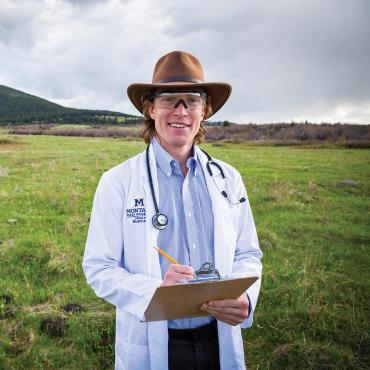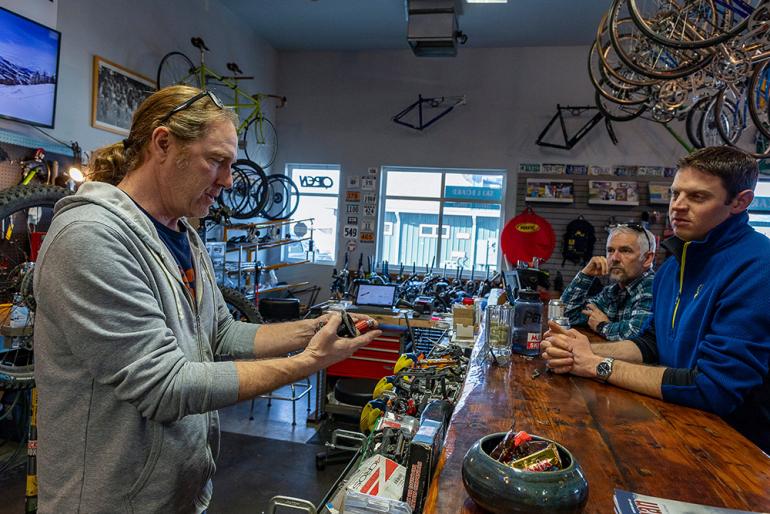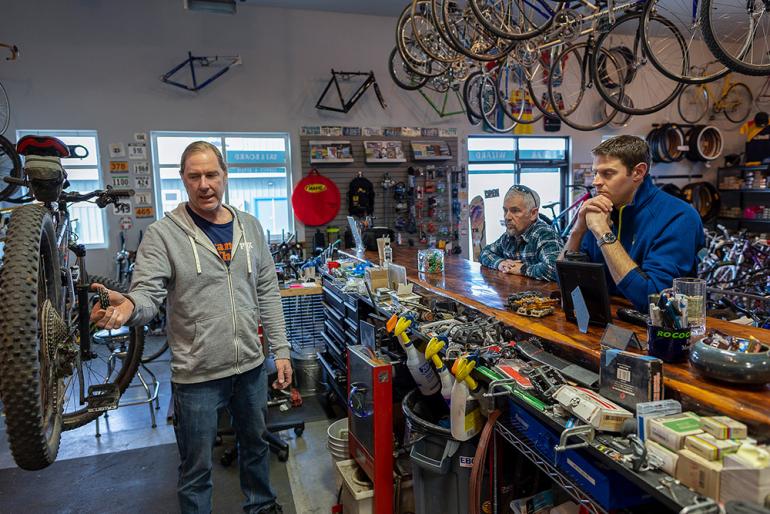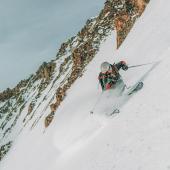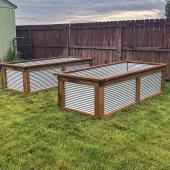Keep 'Em Turning
Bike-maintenance school with the Gear Wizard.
If you’re reading this magazine, there’s a good chance that you own a bicycle. Whether it’s for pedaling the paths around town, tearing down timbered trails, or grinding along gravel roads, two-wheeled locomotion is one of our favorite ways to get around. And as we all know, biking is a lot more fun when you’re riding a smooth, quiet, well-maintained set of wheels rather than a dilapidated piece of junk that’s been collecting dust in the corner of the garage—or worse, caked in grime from your last ride. You probably already know the basics of bike maintenance: fixing a loose chain, changing a tire, and so on. But to keep the wheels turning for many years to come, it pays to get savvy with more advanced upkeep. Somewhat of an art, somewhat of a science, maintaining a bike can be daunting at first. So we went to the Gear Wizard for a dose of expert advice.
Biking season is in full swing, and Brian Wood, owner of Gear Wizard, has a shop full of bikes in for service. Despite this, he’s managed to set aside three hours to give our crew a crash-course on tuning. He starts off by talking us through his approach to tuning a bike. “I like to start at the seat and work around in a circle, to make sure I don’t miss anything,” he says, motioning to the handlebars, then down the fork and to the front wheel, back toward the pedals and rear wheel, and up to the rear suspension. But if we were to take this approach in a three-hour class, we probably wouldn’t make it past the brake levers. So instead we start by looking at the highest wear-and-tear areas on the bike—which, go figure, are the parts that move around the most.
Our interests are piqued and we’ve realized that this ain’t rocket science; it’s just... bike science.
“Your chain needs to be serviced more often than any other part of the bike,” says Brian. “It doesn’t take much effort—cleaning and lubrication go a long way.” That turns out to be the mantra with most bike maintenance.
But it’s not quite that simple. “There are a lot of different chain-oil products out there, and if you don’t get the right one, you may as well be using Italian dressing,” he explains. Brian demonstrates the quality of five different products by putting a drop of oil onto the counter. Most of the droplets quickly spread out into a thin film, but a few hold together in an amoeba-like shape, meaning they’ll stick to the chain better. Brian goes on to demonstrate two different techniques for applying chain oil: “There’s the way I do it, and there’s the way you’ll probably do it at home.” Spoiler: his method is much more exacting and tedious.
Next we get a lecture on derailleur adjustment. We look at different types of cassettes and learn why machined parts are so much more expensive (and more desirable) than cast parts. We get a history lesson on the evolution of bottom brackets, with enough examples on hand to stock a bicycle museum. We are warned about the dangers of setting up a bike with improper crank lengths, and we learn a dirty little trick for truing our brake calipers. If all of this sounds Greek to you, join the club—our heads are spinning, but we’re still tempted to dive deeper on every topic. Why can’t I ever succeed with mounting a tubeless tire at home? Why are my brakes making noise, and how do I make it stop? Why is my friend so much faster than me? All of these questions have answers, no matter how simple or convoluted. But before we know it, it’s time to break class for some burgers and beers.
Most of us are walking away with more questions than we came in with, but our interests are piqued and we’ve realized that this ain’t rocket science; it’s just... bike science. You’ll have to be the judge on which discipline is more complicated. In fact, Brian offers a full curriculum of bike-tuning classes, once service winds down after summer. Starting in September, be on the lookout for a schedule of evening classes covering the whole gamut of bike-maintenance topics. Each lesson will dive deep into one area, and class sizes are kept small to facilitate hands-on learning. Not only will it make you more self-sufficient with your own equipment, but before long, you might be the one teaching fledgling folks how to tune their bikes. Which, at the very least, is a good way to keep the fridge full of beer.

